Best Selling Products
The secret to analyzing website metrics is simple and anyone can do it
Nội dung
- 1. The importance of understanding website metrics
- 2. Why do we need to analyze website metrics?
- 3. Instructions for viewing website visits
- 3.1 Use Google Analytics to view your own website
- 3.1.1 Why use Google Analytics?
- 3.1.2 Steps to access Google Analytics
- 3.2 Use SEMrush and Similarweb to see other websites
- 3.2.1 SEMrush Tool
- 3.2.2 Using Similarweb
- 4. Analyze website traffic metrics
- 4.1 Check traffic to compare with your website
- 4.1.1 Check Traffic for comparison
- 4 .1.2 Assessing the level of brand influence
- 4.1.3 Traffic Analysis
- 4.1.4 Identifying anomalies in visits
- 4.1.5 Solutions to increase traffic
- 4.2 Check traffic to compare with competitor websites
- 4.2.1 Compare Traffic with Competitors
- 4.2.2 Website Development Stages
- 5. Support tools to check traffic
- 5.1 Spamzilla
- 5.2 KWFinder
- 5.3 PiPiads
- 5.4 Zik Analytics
- 5.5 BigSpy
- 5.6 Similarweb
- 5.7 Keywordtool
- 5.8 Ahrefs
- 5.9 SEMRush
- 6. Where should I upgrade my website analytics software?
- 7. Conclusion
Nowadays, it’s not enough to just have an attractive website, you need to understand how users interact with it. Analyzing your website metrics not only helps you understand how it’s performing, but also opens the door to optimizing the user experience and increasing traffic. From tracking traffic to evaluating content effectiveness, each metric provides valuable information that can help you outperform your competitors.
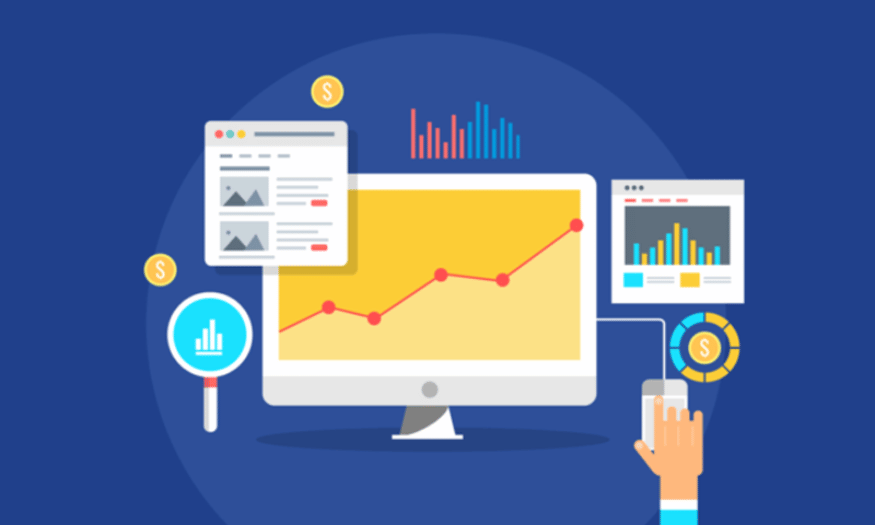
Nowadays, having an attractive website is no longer enough, you need to understand how users interact with it. Analyzing website metrics not only helps you grasp the operational situation but also opens the door to optimizing user experience and increasing traffic. From tracking the number of visits to evaluating the effectiveness of content, each metric provides valuable information to help you overcome your competitors. Join Sadesign to discover simple but effective tips to analyze and optimize your website, making it a powerful tool in your online business strategy!
1. The importance of understanding website metrics
In today’s digital age, owning a website is not simply an online homepage for users to read news. Websites need to operate effectively, attract and retain users, regardless of the field. To achieve this, analyzing website indicators becomes extremely important. Analyzing indicators helps us:
Understand user behavior : By tracking metrics like visits, time spent on site, and bounce rate, we can better understand how users interact with our website.
Content Optimization : Once we know what type of content engages users the most, we can optimize and create more similar content to retain customers.
Tracking the effectiveness of marketing strategies : Analyzing metrics allows us to measure the effectiveness of online marketing campaigns, thereby adjusting strategies accordingly.
Evaluating competitors: Analyzing competitor metrics also helps us understand our position in the industry and find opportunities for improvement.
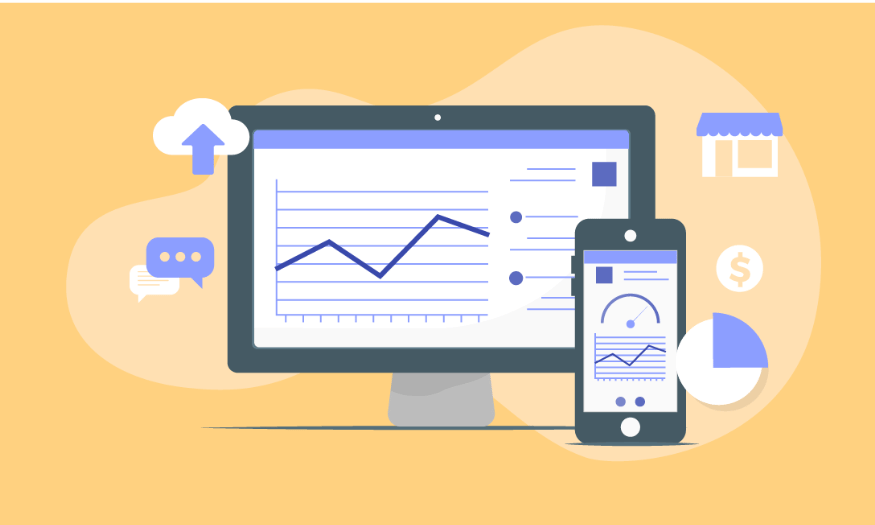
2. Why do we need to analyze website metrics?
Analyzing website metrics not only helps us understand the current situation, but also provides a basis for making strategic marketing decisions in the future. Here are some specific reasons:
Measuring performance : Metrics are the measure of a website’s success. Without clear metrics, it’s hard to know where we stand and what needs to be improved.
Budget Management : Through analysis, we can identify which channels are most profitable and this helps optimize the marketing budget.
Improve user experience : Metrics analysis helps identify problems users encounter, thereby improving user experience.

3. Instructions for viewing website visits
Do you want to know the traffic on your website or your competitors? Grasping this information will not only help you better understand the performance of your website but also support you in making appropriate strategies. There are many ways to view traffic, depending on your level of understanding and needs. Next, Sadesign will guide you in detail on how to view traffic for your website and other websites through popular tools such as Google Analytics, SEMrush and Similarweb
3.1 Use Google Analytics to view your own website
3.1.1 Why use Google Analytics?
Google Analytics is one of the leading web analytics tools that gives you insight into user behavior on your website. With Google Analytics, you will be able to track not only visits but also other metrics such as duration of visit, bounce rate, and traffic sources. This gives you a better understanding of how users interact with your content. However, to access this data, you need to be the website owner or have been granted access.
3.1.2 Steps to access Google Analytics
Step 1: Log in to your Google Analytics account
Go to your Google Analytics account. If you don’t have one, sign up and install the tracking code on your website. Once you’re logged in, you’ll see a variety of views. Choose Master View, which is optimized to filter out unwanted traffic.
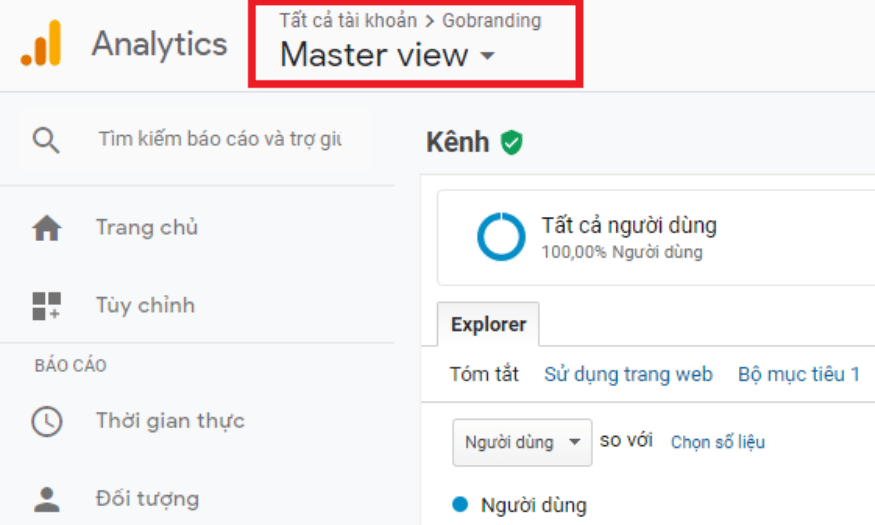
Step 2: Select traffic view
From the main page, look for the “Acquisition” tab. Here, you will see the “All Traffic” and “Channels” options. Select “Channels” to see the traffic sources to your website.
Step 3: Adjust the time
For a more accurate view of your visits, adjust the time period in the upper right corner of the screen. You can select a specific time period, from day to day, or use the available options like last week, last month.
Step 4: View results
Scroll down to the bottom of the page and you’ll see a statistics table with a “Sessions” column. This is the total number of visits to your website during the selected time period. Attribution metrics by traffic source such as Organic Search, Referral, Direct, and Social will help you better understand how users find your website.
Additionally, Google Analytics also has mobile app support, making it easy to track traffic anytime, anywhere.
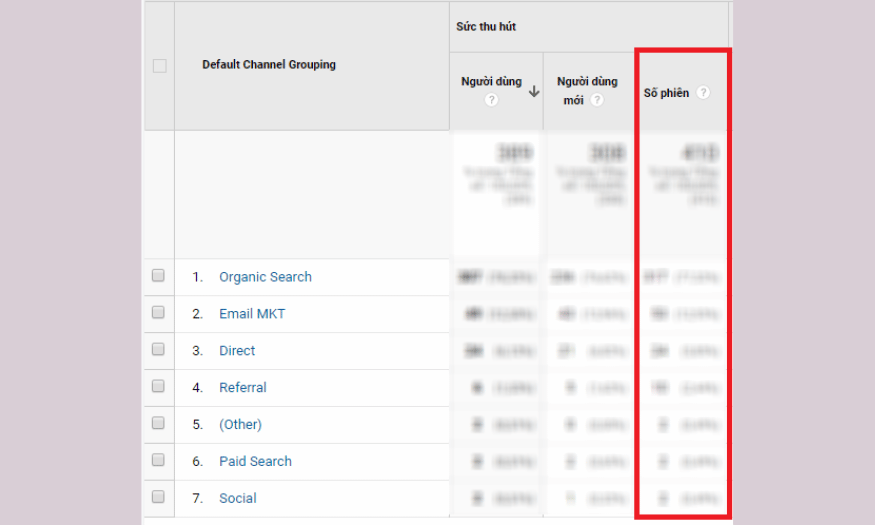
3.2 Use SEMrush and Similarweb to see other websites
If you are looking for information about the traffic of a particular website, there are many useful tools that can help you do this quickly and effectively. Knowing the traffic will not only help you evaluate the strength of your website but also allow you to discover potential opportunities in your business field. Some prominent tools such as SEMrush and Similarweb will help you have a clear and deep view of the traffic of the websites you are interested in. Let's learn how to use these tools to track and analyze the traffic of any website.
3.2.1 SEMrush Tool
SEMrush is one of the leading SEO analysis tools, used by many marketers and businesses to track website performance. With SEMrush, you can not only see traffic but also analyze other SEO metrics, thereby creating more effective marketing strategies.
Step 1: Go to SEMrush
First, you need to go to the SEMrush homepage. Here, you will see a variety of features. Look for the “Traffic Analytics” section, which is where important traffic information is gathered. You can use SEMrush without signing up for an account, but if you want to take full advantage of the features, creating an account will be more beneficial.
Step 2: Enter the website to check
Once you’re in Traffic Analytics, you’ll see an input box to add the websites you want to check. SEMrush allows you to import up to 5 websites at once. This is useful if you want to compare traffic between your website and your competitors.
Step 3: Explore traffic information
Once you’ve entered the websites you want to audit, SEMrush will give you an overview of their traffic. You’ll see important metrics like:
Visits : Total number of visits to the website in a period of time.
Unique Visitors : The number of different users who have visited the website.
Pages per Visit : The average number of pages each user views during a visit.
Bounce Rate : The percentage of users who leave a website after viewing only one page.
These metrics will help you evaluate the appeal and effectiveness of your website.
Step 4: Analyze traffic sources
One of the notable features of SEMrush is the ability to analyze traffic sources. You will know where your traffic is coming from, such as:
Direct : Users type the website URL directly.
Referral : Traffic from other websites through links.
Search : Users search on search engines like Google.
Social : Traffic from social networks like Facebook, Instagram, Twitter.
Paid : Traffic from paid advertising.
Analyzing traffic sources helps you better understand how users find your website and thereby optimize your marketing strategies.
Step 5: Use Audience Overlap
SEMrush’s Audience Overlap feature allows you to see how many people visit both your website and your competitors’ websites. This is a powerful tool for you to evaluate your market share and find opportunities to attract customers from your competitors.
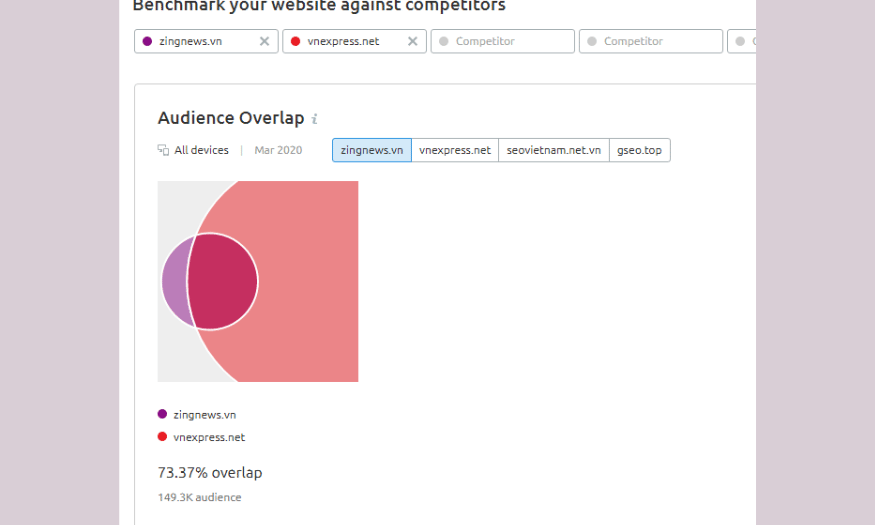
3.2.2 Using Similarweb
If you’re looking for a free tool that still provides useful traffic information, Similarweb is a great option. While some features may be limited, Similarweb still provides a good overview of important website metrics.
Step 1: Visit Similarweb
To get started, simply visit Similarweb . Similarweb's interface is very friendly and easy to use, so you don't need much experience to get started.

Step 2: Enter the URL to check
On the main page, you will see an input box to enter the URL of the website you want to check. For example, you can enter the address of a competitor to see information about their visits.
Step 3: View results
After entering a URL, Similarweb will give you the total number of visits over the past 6 months. You will also see the distribution of traffic by sources such as Search, Social, Referral, and Direct. While it may not be as accurate as Google Analytics, it still gives you a good idea of how competitive your website is.
Step 4: Explore the metrics
In addition to traffic information, Similarweb also provides a number of other useful metrics such as:
Average Visit Time : The time a user spends on a website.
Bounce Rate : Similar to SEMrush, you can also find the bounce rate of the website.
Traffic sources : See the sources from which users come to your website, thereby evaluating the effectiveness of your marketing campaigns.
Step 5: Identify trends
One of Similarweb's strengths is its ability to track traffic trends over time. This helps you stay on top of fluctuations and adjust your marketing strategy in a timely manner to optimize effectiveness.
4. Analyze website traffic metrics
Analyzing your website traffic is an important task that helps you evaluate the effectiveness of your online activities. To do this effectively, you need to have baseline data to compare. Comparisons can take place in two main directions: against your own website and against your competitors.
4.1 Check traffic to compare with your website
4.1.1 Check Traffic for comparison
To evaluate the performance of your website, it is necessary to check the traffic periodically. You should compare current data with historical data, this will help you identify trends and anomalies in traffic. It is recommended to do this check at least once a month.
Let's say you have the following traffic test results:
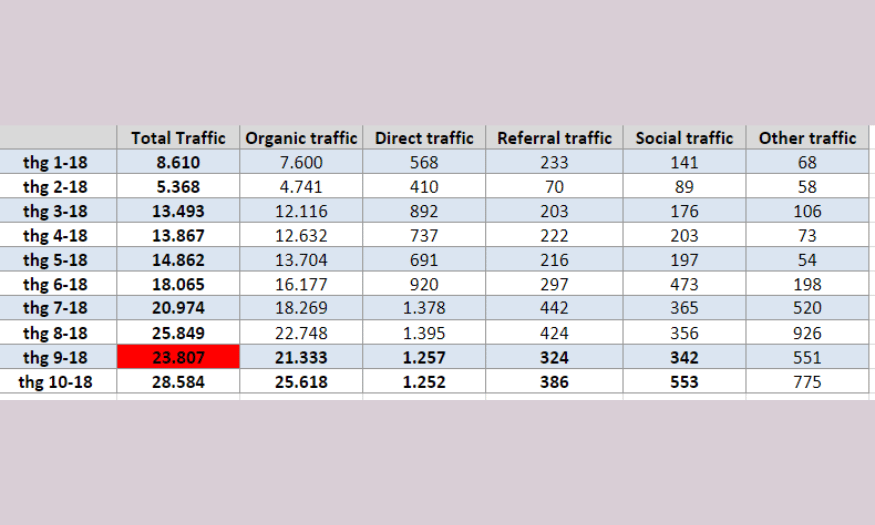
Based on the hypothetical data table, we can see that the main sources of traffic come from organic search and direct traffic. These two sources usually take a long time to develop and cannot grow immediately like advertising forms. However, once firmly established, they will ensure stable and sustainable traffic.
4 .1.2 Assessing the level of brand influence
A key metric for assessing online brand strength is direct traffic . Direct traffic shows that users have remembered and visited your website without going through any other channel. An increase in direct traffic not only indicates customer loyalty but can also increase the likelihood of conversion to a purchase. The goal is to maintain above 1,000 direct visits per month, which demonstrates that your brand has strong appeal.
4.1.3 Traffic Analysis
The “total traffic” column shows that your website is growing. This growth comes from various online marketing channels such as search engine optimization (SEO), providing quality content, sharing on social media, and online advertising. If total traffic is increasing, it means that you are attracting more users from different sources.
4.1.4 Identifying anomalies in visits
However, if you notice a drop in traffic, like in September, there are a few factors to consider. It could be that your Facebook, Google, or email marketing budgets are being cut, leading to a slight drop in direct traffic. If you have 500 customers who normally receive your weekly emails and don’t receive them in September, chances are they’re forgetting about you.
In particular, traffic from organic search decreased sharply (nearly 1,500 visits). The reason could be:
SEO Issues : If your website is no longer on the top of Google, you will lose a lot of traffic. To track your keyword rankings, use tools like Google Search Console. If your keywords are no longer on the first page, your traffic will drop significantly.
Changing Search Demand : Search demand can change due to many factors such as market trends, culture, or special holidays that are not favorable to your industry. For example, a particular keyword may be searched more in the summer months but decrease in the winter.
4.1.5 Solutions to increase traffic
To maintain and develop your website, you need:
Diversified SEO : Optimize for multiple keywords and track search trends. This helps you avoid relying on just one or two main keywords.
Provide quality content : Always update with fresh and useful information to attract users. High-quality content not only keeps users engaged but also encourages them to share.
Track and analyze : Use Google Webmaster Tools to see which keywords bring in the most traffic and Google Keyword Planner to track search demand. This helps you adjust your SEO and marketing strategies more effectively.
4.2 Check traffic to compare with competitor websites
4.2.1 Compare Traffic with Competitors
Whether you are running a traditional or online business, knowing your competition is essential. Competition in the online market, especially on Google, requires you to have an in-depth look at your competition. Website traffic is an important factor in assessing your competitive strength.
Checking and comparing traffic between you and your competitors helps you clearly identify the current SEO capabilities of your website. From there, you can decide whether to compete directly with the keywords that your competitors are using or switch to a niche keyword strategy to avoid fierce competition.
Instead of checking your traffic monthly like you do with your website, do it every 6 months to a year. This allows you to get a better overview and make informed strategic decisions.
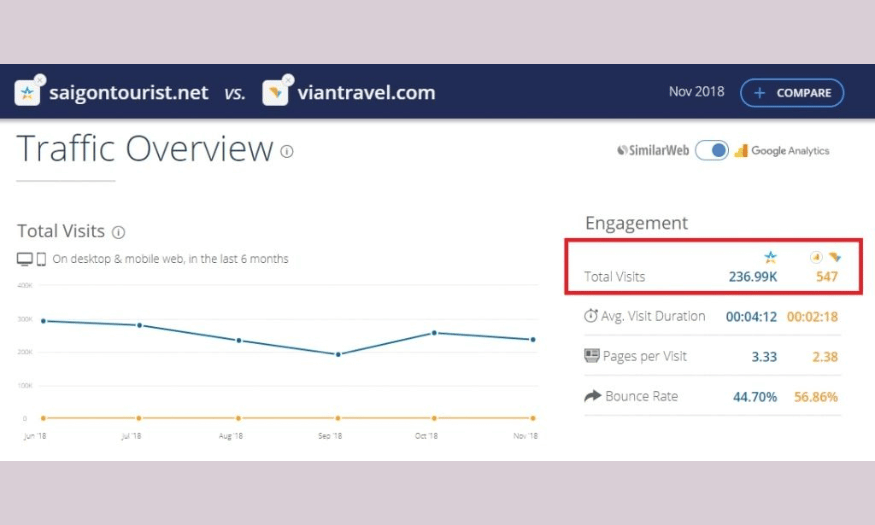
4.2.2 Website Development Stages
Phase 1
In the initial stages, your new website will only attract a very small amount of traffic, like a "grain of sand in the ocean." This is an important time to optimize the website structure according to Google's standards. You need to publish a lot of valuable content in the blog section, making sure it is optimized for SEO from the beginning. At the same time, invest in advertising channels such as Facebook, YouTube, Google Ads and Email to attract initial traffic.
Once you have reached around 50-100 articles and your monthly traffic is around 10% of your strongest competitor, consider investing more in SEO. At this point, optimization becomes more feasible.
Phase 2
Once you have achieved some success, comparing yourself to your big competitors can make you feel like you are on a seesaw tilted in their favor. Your traffic is still modest. To have a better chance at SEO, focus on your core product or service and identify related keywords.
Drill down into specific customer search intent to develop specific keywords. Product or service needs are often segmented into multiple search intents, which reduces competition. Additionally, geographic advantage helps you attract potential customers.
If your budget is limited, start with about 10 keywords. But don't stop there. As you gain more budget, expand to 20, 30 keywords... The more keywords, the higher your chances of ranking!
Phase 3
When you check your traffic, you will see that the number of visits from Organic Search (thanks to SEO) has increased significantly. The keywords from phase 2 will become a solid foundation, helping you compete directly with big competitors through short, comprehensive keywords. At the same time, your revenue has also increased during the development of phases 1 and 2. By phase 3, you will have enough budget to invest heavily in SEO for these difficult keywords.
5. Support tools to check traffic
SEO analysis tools will help you better understand user behavior, thereby optimizing marketing strategies and improving business efficiency. Below are 9 outstanding tools that support traffic checking that you cannot ignore.
Website analytics tools
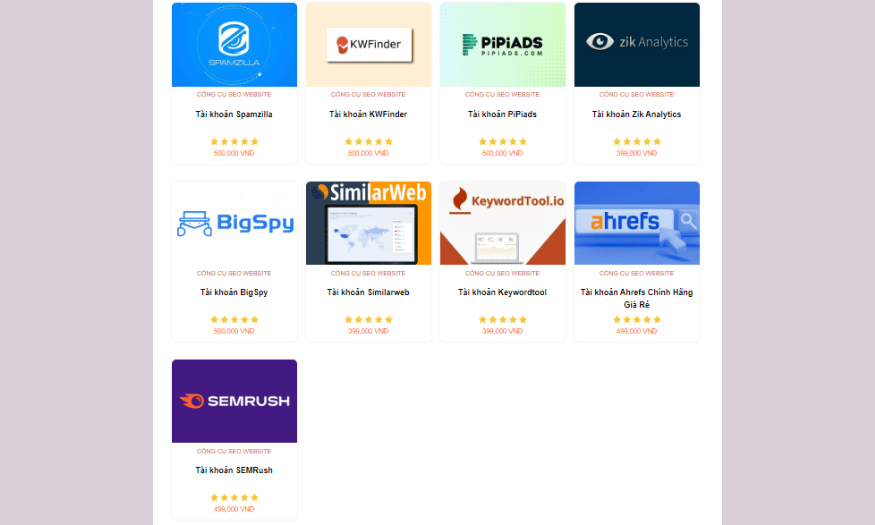
5.1 Spamzilla
Spamzilla helps you detect and handle unwanted traffic sources. It helps you track untrustworthy links and remove them from your website, thereby protecting your website from negative impacts. Reducing bad traffic will help you focus on improving your content and services for customers who really care.
5.2 KWFinder
KWFinder is the ideal tool for finding high-potential keywords. It provides detailed information about the search volume and competition of each keyword. Knowing which keywords are attracting users' attention allows you to create engaging and relevant content that will help your website attract more traffic and improve your search rankings.
5.3 PiPiads
PiPiads allows you to track the performance of your advertising campaigns across platforms like Facebook and Google Ads. It provides insights into which ads are performing well, helping you adjust your budget and optimize your ad copy for the best results. With the information from PiPiads, you can save on advertising costs and improve campaign performance.
5.4 Zik Analytics
This is a great tool for e-commerce sites. It helps you analyze data, track traffic and consumer behavior. By understanding shopping trends, you can adjust your business strategy to better suit the needs of the market. This tool also helps you identify hot products, thereby making smarter business decisions.
5.5 BigSpy
BigSpy helps you track your competitors' advertising campaigns. By reviewing the ads that are performing well, you can learn lessons for your own campaigns. This tool helps you stay on top of trends and develop new advertising ideas, giving your business a competitive edge.
5.6 Similarweb
Similarweb is a useful website analytics tool that helps you understand your traffic and where it comes from. It allows you to compare your website performance with your competitors, thereby improving your content and marketing strategy. With Similarweb, you can learn about user behavior and identify effective marketing channels.
5.7 Keywordtool
Keywordtool helps you find potential keywords for your content and ads. It provides a rich and accurate list of keywords, helping you better understand consumer needs. When you know who is searching for what, you can create relevant content and attract the right audience.
5.8 Ahrefs
Ahrefs is considered a leading SEO analysis tool that helps you track links to your website and analyze keyword rankings. This tool provides detailed information about your competitors' SEO strategies, thereby helping you find opportunities to optimize your website. Using Ahrefs will improve the quality of your content and improve your competitive position.
5.9 SEMRush
It’s not just a keyword analysis tool, it also provides information about SEO, PPC, and social media. It helps you monitor your website performance, find problems to fix, and optimize your advertising campaigns. With SEMRush, you can discover new keywords with potential and adjust your overall marketing strategy.
Website analytics tools
6. Where should I upgrade my website analytics software?
If you want to upgrade your website analytics software, Sadesign is the top choice that you should not miss. Here are some reasons why you should upgrade at Sadesign:
Reliable products: Sadesign provides genuine SEO analysis software accounts from reputable providers such as Ahrefs, SEMRush, Similarweb,.... This ensures you get accurate data for your SEO strategies.
Reasonable price: With competitive prices, Sadesign brings you effective analytical solutions without having to spend too much money. Accounts like Ahrefs or SEMRush start from only 499,000 VND, helping you save your budget for other activities.
Dedicated customer support: Sadesign's customer support team is always ready to help you during the process of upgrading, installing and using the software. You will not have difficulty when you need to learn or answer questions.
Diverse resources: Sadesign not only provides SEO analysis software but also has many other useful resources such as design presets, graphic stores and other support tools. This helps you optimize your website design and analysis work effectively.
7. Conclusion
Analyzing your website metrics is an essential part of optimizing your online performance. By understanding these metrics, you can improve your content, optimize your user experience, and increase traffic. Upgrade your analytics today to turn your website into a powerful platform to attract and retain customers!












































